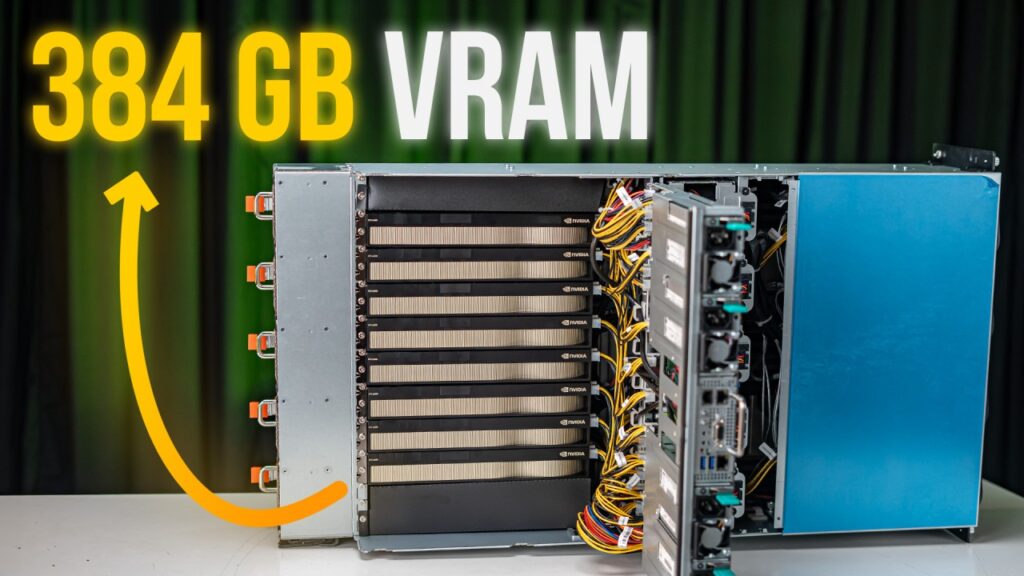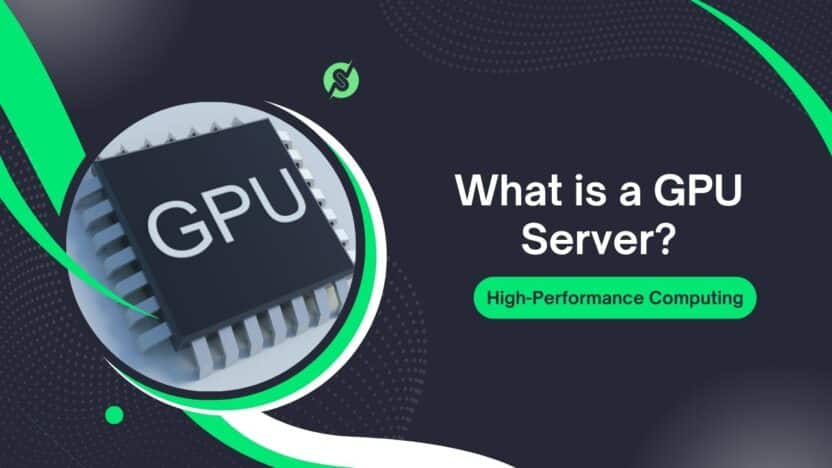Imagine you’re a game developer crafting the next big open-world adventure, or maybe you’re a data scientist training an AI model to predict weather patterns.
Your regular computer starts chugging, overheating, and begging for mercy as it tries to handle the massive calculations. You’re stuck waiting hours—or days—for results, and your deadlines are looming like storm clouds.
Then, someone whispers, “You need a GPU server!” Suddenly, it’s like upgrading from a bicycle to a supersonic jet.
But hold up—what exactly is a GPU server, and why is it the secret weapon for AI, gaming, and scientific breakthroughs in 2025?
If you’re a developer, researcher, or business owner diving into AI, machine learning, gaming, or high-performance computing (HPC), GPU servers are your ticket to lightning-fast processing without the meltdown.
Whether you’re eyeing NVIDIA GPUs on AWS, Azure, or Hetzner, this 2025 guide to GPU servers breaks down what they are, how they work, and why they’re game-changers.
We’ll cover components, benefits, use cases, and tips to get started, plus a comparison table and much more to solve all your questions. Ready to turbocharge your projects?
Let’s zoom into the world of GPU servers!
What is a GPU Server?
A GPU server is a high-powered computer server equipped with one or more Graphics Processing Units (GPUs) alongside traditional Central Processing Units (CPUs).
Unlike CPUs, which handle general tasks sequentially, GPUs excel at parallel processing, tackling thousands of calculations simultaneously.

This makes GPU servers perfect for compute-intensive tasks like AI training, deep learning, 3D rendering, and scientific simulation.
Think of a GPU server as a superhero sidekick for your CPU. While the CPU manages the big-picture stuff (like running the OS), the GPU crunches massive datasets at warp speed, thanks to thousands of tiny cores built for tasks like matrix operations or rendering graphics.
These servers are often hosted in data centers by providers like AWS, Microsoft Azure, or Google Cloud, or built on-site with hardware from Supermicro, Dell, or HPE.
Key Features:
- High-Performance GPUs: NVIDIA A100, H200, or AMD Instinct MI300X for top-tier performance.
- Parallel Processing: Handles thousands of threads at once, ideal for AI and rendering.
- Scalability: Add more GPUs or scale via cloud providers like AWS EC2 G5.
- Cooling Systems: Air or liquid cooling to manage heat.
Why GPU Servers Matter in 2025
GPU servers are the backbone of modern computing, with the GPU-as-a-service market booming (projected to grow significantly).
AI and Machine Learning: Train complex models for ChatGPT-like AI or image recognition in hours, not months.
- Gaming and VR: Render high-quality graphics for cloud gaming platforms like NVIDIA GeForce NOW.
- Scientific Research: Simulate climate models or genomic data faster than CPU-only servers.
- Cost Efficiency: Cloud GPU servers (e.g., Azure NVv4) reduce upfront hardware costs.
- Energy Efficiency: GPUs use less power per computation than CPUs for parallel tasks.
Components of a GPU Server
A GPU server is like a high-tech recipe, blending powerful ingredients for maximum performance.
- GPUs: The star of the show, like NVIDIA H200 or AMD MI325X, with thousands of cores for parallel tasks.
- CPUs: Workhorses like Intel Xeon or AMD EPYC to manage system tasks and non-GPU code.
- RAM: High-capacity memory (e.g., 128GB DDR5) for smooth data handling.
- Storage: Fast NVMe SSDs (e.g., 2TB) to reduce data access bottlenecks.
- Cooling: Liquid or air cooling to keep GPUs from overheating.
- Power Supply: High-wattage PSUs (e.g., 2600W) to support multiple GPUs.
- Networking: High-speed Ethernet or InfiniBand for data transfer.
Types of GPU Servers
GPU servers come in various flavors, each tailored to specific needs:
- Single-GPU Servers:
- Best for small projects or entry-level AI tasks.
- Example: Dell PowerEdge R750xa with one NVIDIA A100.
- Multi-GPU Servers:
- Handle large-scale AI or HPC workloads with 4–16 GPUs.
- Example: ASUS 4U server with 8 NVIDIA H200 GPUs, per asus.com.
- Cloud-Based GPU Servers:
- Scalable, on-demand GPUs via AWS EC2 P4d, Azure NDm A100, or Google Cloud A3.
- Example: A developer rents AWS G5 instances for 3D rendering.
- Rack-Mounted GPU Servers:
- Fit in data center racks (1U–8U) for high density.
- Example: HPE ProLiant DL385 Gen10 with 4 GPUs, per hpe.com.
Use Cases for GPU Servers in 2025
GPU servers shine in industries needing massive computational power. Here are the top use cases:
- AI and Machine Learning:
- Train neural networks for LLMs (e.g., GPT-4) or image recognition.
- Example: A company uses NVIDIA DGX A100 on AWS to build a chatbot.
- Gaming and VR:
- Power cloud gaming or render VR worlds with low latency.
- Example: NVIDIA GeForce NOW uses GPU servers for 4K streaming.
- Scientific Simulations:
- Model climate change, physics, or genomics data.
- Example: A university runs simulations on HPE GPU servers for drug discovery.
- Video Rendering and Editing:
- Process 8K videos or 3D animations in real-time.
- Example: A studio uses Azure NVv4 for Pixar-quality animations.
- Cryptocurrency Mining:
- Perform complex calculations for blockchain verification.
- Example: Miners use AMD MI300X GPUs on Hetzner servers.
- Medical Imaging:
- Analyze CT scans or MRIs for faster diagnoses.
- Example: A hospital uses Supermicro GPU servers for real-time imaging.
Benefits of GPU Servers
GPU servers offer a slew of perks, per milesweb.in and serverbasket.com:
- Blazing Speed: Process tasks 10–100x faster than CPU-only servers.
- Parallel Processing: Handle thousands of calculations simultaneously.
- Cost Savings: Cloud GPUs (e.g., Google Cloud A3) eliminate hardware purchases.
- Scalability: Add GPUs or scale cloud instances as needed.
- Energy Efficiency: Use less power per computation than CPUs.
- Flexibility: Support diverse workloads, from AI to gaming.
Comparison Table: GPU Server Providers
| Provider | Key Offering | Best For | Starting Price |
| AWS EC2 P4d | NVIDIA A100 GPUs, high-speed networking | AI, ML, HPC | ~$3.06/hr |
| Azure NDm A100 | NVIDIA A100, scalable cloud instances | Deep learning, simulations | ~$3.67/hr |
| Google Cloud A3 | NVIDIA H100 GPUs, AI-optimized | LLMs, cloud gaming | ~$4.10/hr |
| Hetzner GPU Servers | NVIDIA RTX 4000, affordable VPS | Small projects, crypto mining | ~$50/mo |
| Supermicro | Custom 8-GPU servers (H100, MI300X) | On-premises AI, research | ~$10,000 |
FAQs About GPU Servers
Q1: What is a GPU server?
Ans: A server with GPUs for parallel processing, ideal for AI, gaming, and HPC, per hpe.com.
Q2: How is a GPU server different from a CPU server?
Ans: GPU servers excel at parallel tasks (e.g., AI training), while CPU servers handle general tasks, per cudocompute.com.
Q3: What are the best GPUs for servers in 2025?
Ans: NVIDIA H100, A100, and AMD MI300X for AI and HPC, per nvidia.com.
Q4: Can I rent GPU servers?
Ans: Yes, via AWS EC2, Azure, Google Cloud, or Hetzner, starting at $3/hr, per cloudminister.com.
Q5: Are GPU servers energy-efficient?
Ans: Yes, they use less power per computation than CPUs for parallel tasks, per milesweb.in.
Conclusion: Why GPU Servers Are Your 2025 Powerhouse
That’s the full scoop on what a GPU server is! These high-octane machines, packed with NVIDIA, AMD, or Intel GPUs, are revolutionizing AI, gaming, scientific research, and more in 2025.
Whether you’re training a neural network on AWS EC2 P4d, rendering VR worlds on Azure NVv4, or mining crypto on Hetzner, GPU servers deliver unmatched speed and scalability.
With providers like Supermicro and Dell offering custom hardware and cloud platforms making GPUs accessible, there’s never been a better time to dive in.
Try a Google Cloud A3 instance for AI or a Hetzner VPS for small projects—many offer free trials. Got a favorite GPU server use case or provider? Share it in the comments—I’d love to hear! For more tech tips, check out our guides on 10 Best Dedicated Servers for Streaming or Best Icarus Dedicated Servers.
Here’s to powering your projects with GPU servers in 2025!




